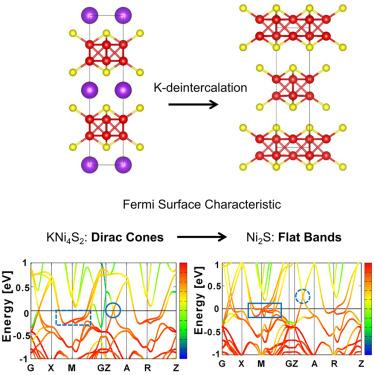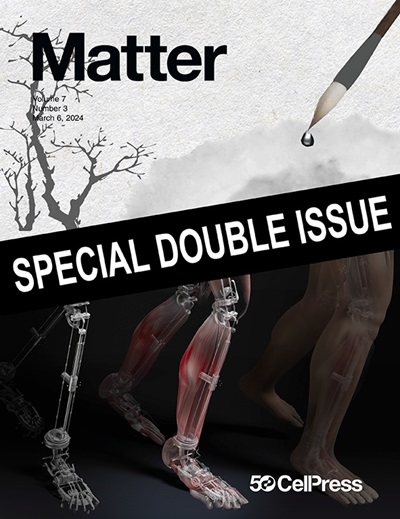层状KxNi4S2从拓扑Dirac金属到平带诱导反铁磁体的演化(0≤x≤1)
IF 17.5
1区 材料科学
Q1 MATERIALS SCIENCE, MULTIDISCIPLINARY
引用次数: 0
摘要
具有狄拉克锥和平带共存以及在单一系统中两者之间可切换控制的凝聚态系统是理想的,但非常罕见。在这里,我们报道了一种层状量子材料系统KxNi4S2(0≤x≤1),它同时具有这两种特性,而不涉及典型的Kagome/蜂窝晶格。通过拓扑化学k脱嵌过程,费米表面可以在很宽的能量范围内连续微调。因此,具有拓扑非平凡Z2指数为1的非磁性狄拉克-金属态;(000)得到第一性原理计算的支持,在富K的x = 1侧观察到高达1,471 cm2V−1s−1的高迁移率,而当K含量接近0时,出现了TN高达10.1 K的平带诱导反铁磁态。KxNi4S2系统为探索新兴现象提供了一个通用的平台,并强调了由狄拉克锥、平带及其相互作用主导的量子材料的原位控制的可行途径。本文章由计算机程序翻译,如有差异,请以英文原文为准。

Evolution from topological Dirac metal to flat-band-induced antiferromagnet in layered KxNi4S2 (0 ≤ x ≤ 1)
Condensed matter systems with coexisting Dirac cones and flat bands and a switchable control between them within a single system are desirable but remarkably uncommon. Here, we report a layered quantum material system, KxNi4S2 (0 ≤ x ≤ 1), that simultaneously hosts both characteristics without involving typical Kagome/honeycomb lattices. Enabled by a topochemical K-deintercalation process, the Fermi surface can be fine-tuned continuously over a wide range of energies. Consequently, a non-magnetic Dirac-metal state with a topological nontrivial Z2 index of 1;(000), supported by first-principles calculations and high mobility up to 1,471 cm2V−1s−1, is observed on the K-rich x = 1 side, whereas a flat-band-induced antiferromagnetic state with TN up to 10.1 K emerges as the K-content approaches 0. The KxNi4S2 system offers a versatile platform for exploring emerging phenomena and underscores a viable pathway for in situ control of quantum materials dominated by Dirac cones, flat bands, and their interplay.
求助全文
通过发布文献求助,成功后即可免费获取论文全文。
去求助
来源期刊

Matter
MATERIALS SCIENCE, MULTIDISCIPLINARY-
CiteScore
26.30
自引率
2.60%
发文量
367
期刊介绍:
Matter, a monthly journal affiliated with Cell, spans the broad field of materials science from nano to macro levels,covering fundamentals to applications. Embracing groundbreaking technologies,it includes full-length research articles,reviews, perspectives,previews, opinions, personnel stories, and general editorial content.
Matter aims to be the primary resource for researchers in academia and industry, inspiring the next generation of materials scientists.
 求助内容:
求助内容: 应助结果提醒方式:
应助结果提醒方式:


